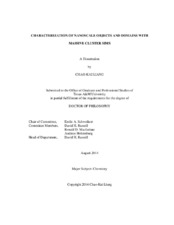| dc.contributor.advisor | Schweikert, Emile | |
| dc.creator | Liang, Chao-Kai | |
| dc.date.accessioned | 2015-02-05T20:58:41Z | |
| dc.date.available | 2016-08-01T05:30:12Z | |
| dc.date.created | 2014-08 | |
| dc.date.issued | 2014-07-31 | |
| dc.date.submitted | August 2014 | |
| dc.identifier.uri | https://hdl.handle.net/1969.1/153571 | |
| dc.description.abstract | Secondary ion mass spectrometry (SIMS) with a massive cluster projectile and run in the event-by-event bombardment/detection mode has been applied to perform nanoscale analysis. Massive clusters, specifically Au_(400)^(4+), at hypervelocity feature efficient production of multiple secondary ions (SIs) desorbed from a nanometric volume per impact. The SIs from each projectile impact are collected and recorded as an individual event. Investigation of individual nano-objects with SIMS can thus be achieved by probing the objects one-at-a-time, avoiding issues due to ensemble averaging and neighboring effects.
Presented here are experiments where individual nano-objects of two categories were examined with 520 keV Au_(400)^(4+) in the event-by-event mode. Biological nano-objects, Qβ and M13 bacteriophages were dispersed by drop-casting onto a nanostructured substrate. By compiling the events containing an ion characteristic of the object, mass spectra specific to the phages can be extracted. A further refinement is the exclusion of the events containing a substrate-specific ion to minimize interference from the substrate. For metallic nano-objects, a series of gold nanoparticles (AuNPs) ranging from 2-50 nm was investigated. The AuNPs were dispersed and immobilized on silicon wafers. The results are the first experimental documentation of NP-size dependent SI yields. They can be significantly enhanced over those from bulk samples when projectile and NP characteristics are matched for efficient energy transfer. These observations point out the necessity of accurate data interpretation when dealing with nano-scaled objects.
The capability of nano-domain analysis was demonstrated with fuel cell cathode materials consisting of pyrolized catalyst/carbon black mixtures. The coincidence methodology allowed to reveal variations in the chemical environment of the catalytically active sites at a nano-scale as a function of pyrolysis temperature. Additionally we could quantify the dispersion of the active sites on the carbon black, a measure providing a direction for future device optimization.
A new SIMS approach was developed for characterizing nanoparticles of ≦10 nm. SIs emitted in the transmission direction from Au_(400)^(4+) impacts on nanoparticles were collected. The feasibility of the approach was tested with 5 nm dodecanethiol-capped AuNPs supported on free-standing graphene sheets. Our results reveal a new mode of energy partitioning, specific to 2D material, causing prolific sputtering and enhanced ionization. The AuNPs yielded analyte-specific peaks including from the dodecanethiol in comparison to emission in the conventional reflection mode. The coincidence methodology allowed also to determine the surface coverage of the 5 nm AuNPs. | en |
| dc.format.mimetype | application/pdf | |
| dc.language.iso | en | |
| dc.subject | Massive Cluster Projectile | en |
| dc.subject | SIMS | en |
| dc.subject | Nanoscale Analysis | en |
| dc.subject | Co-Emission Secondary Ions | en |
| dc.title | Characterization of Nanoscale Objects and Domains with Massive Cluster SIMS | en |
| dc.type | Thesis | en |
| thesis.degree.department | Chemistry | en |
| thesis.degree.discipline | Chemistry | en |
| thesis.degree.grantor | Texas A & M University | en |
| thesis.degree.name | Doctor of Philosophy | en |
| thesis.degree.level | Doctoral | en |
| dc.contributor.committeeMember | Russell, David | |
| dc.contributor.committeeMember | Macfarlane, Ronald | |
| dc.contributor.committeeMember | Holzenburg, Andreas | |
| dc.type.material | text | en |
| dc.date.updated | 2015-02-05T20:58:41Z | |
| local.embargo.terms | 2016-08-01 | |
| local.etdauthor.orcid | 0000-0003-4438-669X | |


